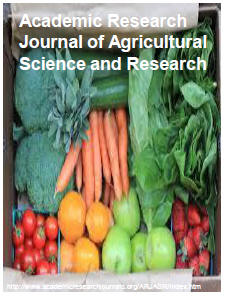| ARJASR |
Academic Research Journal of
Agricultural Science and Research |
||||||||||||||||||||||
|
Academic Research Journal of Agricultural Science and Research Vol. 3(4), pp. 60-70. April, 2015. ISSN: 2360-7874 DOI: 10.14662/ARJASR2015.005
Full Length Research IDENTIFICATION OF RESISTANT SOURCE IN LENTIL GERMPLASM AGAINST FUSARIUM WILT IN RELATION TO ENVIRONMENTAL FACTORS
Kanwal Fatima1, Muhammad Aslam Khan1, *Muhammad Mohsin Raza1, Muhammad Yaseen2, Muhammad Azhar Iqbal3, Muhammad Umar Shahbaz3
1Department of Plant Pathology, University of Agriculture Faisalabad, Pakistan. 3Department of Mathematics and Statistics, University of Agriculture Faisalabad. 3Pulses Research Institute, Ayub Agricultural Research Institute *Corresponding Authorís Email: mohsinuaf@live.com. Cell # = +923238410682
Accepted 9 March 2015
Lentil is a valuable human food and one of the oldest known protein rich food legumes which is also known as poor menís meat. Owing to biotic and abiotic stresses, the crop yield is below attainable levels which are mainly attributed to pathological factors especially lentil wilt caused by Fusarium oxysporum f.sp. lentis. It is a potential threat to lentil production not only in Pakistan but worldwide as well that can cause complete crop failure. Current studies were designed to screen the available lentil germplasm against the lentil wilt disease in relation to environmental factors. Twenty eight lentil lines were sown in a previously developed wilt sick bed in the research area of Pulses Research institute, Faisalabad using augmented design. Natural inoculum was also relied upon. Disease severity data were recorded and area under disease progress curve was calculated. Results revealed that sixteen lines were found highly susceptible, seven remained susceptible, and three lines were moderately resistant whereas two demonstrated resistance responses against the disease. Furthermore, disease severity data along with weekly environmental conditions were subjected to correlation and stepwise regression analysis to screen environmental variables not having a significant influence on lentil wilt development. All the environmental factors were positively correlated with disease development and best explained using linear regression. Maximum disease severity was recorded at 17-18oC and 7-10oC air temperature (Max. and Min.), 60-78% relative humidity and 2 mm rainfall respectively. Stepwise regression employed to predict lentil wilt incidence, the model developed significantly fit to the data and their predicted values of lentil wilt incidence were in close conformity with the observed values.
Key words: Lentil, Lentil wilt, Fusarium oxysporum f.sp. lentis, Correlation, Stepwise regression and linear regression.
How to cite this article: Fatima K, Khan MA, Raza MM, Yaseen M, Iqbal MA, Shahbaz MU (2015). IDENTIFICATION OF RESISTANT SOURCE IN LENTIL GERMPLASM AGAINST FUSARIUM WILT IN RELATION TO ENVIRONMENTAL FACTORS. Acad. Res. J. Agri. Sci. Res. 3(4):60-70.
|
|
|||||||||||||||||||||
